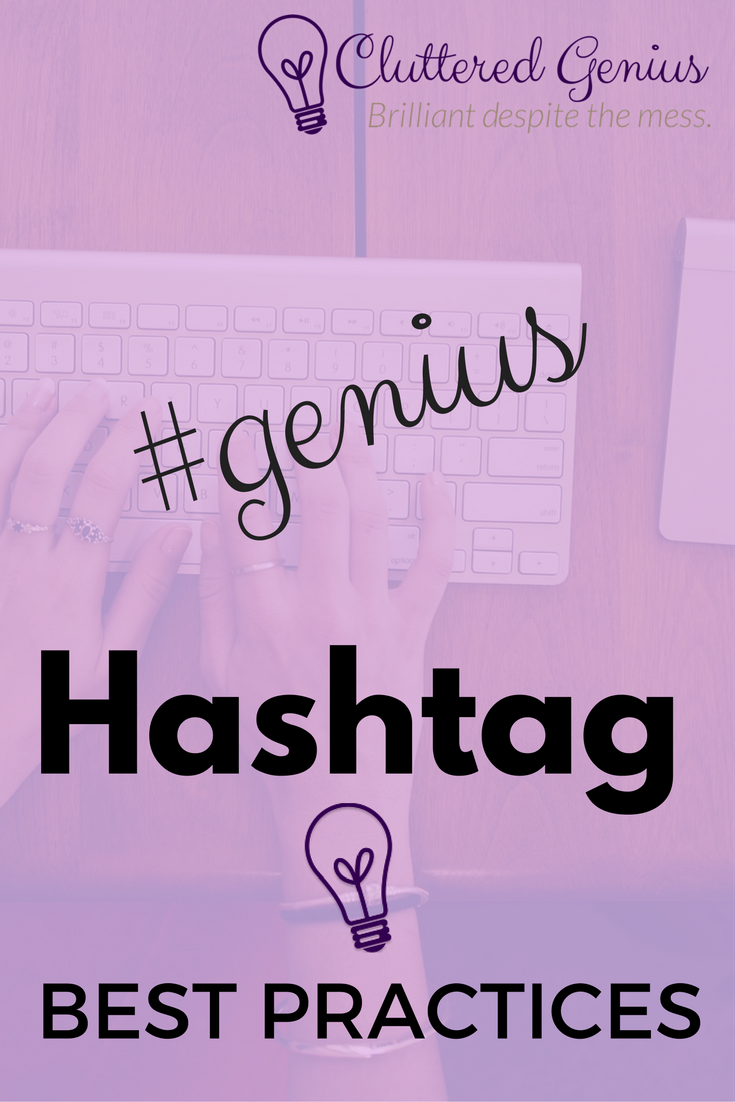Hashtag Best Practices

Hashtag. The first time I ever heard that word, something about it struck me funny. It sounded like a dirty word, and I jokingly told my friend (who is a genius, and who I should have never doubted) that it sounded like she was trying to curse me. I didn’t realize how much I would use that word and put into practice the use of hashtags in the years to come.
If you’re reading this and wondering what the hay hay a hashtag is, take a second and watch this quick video. It gives you a down and dirty explanation of the definition and basic purpose of hashtags.
Maybe you fully understand what a hashtag is, but you aren’t sure what you’re supposed to do with a hashtag or how to best utilize. So let’s talk about hashtag best practices.

Use them for categories
As we’ve already covered, hashtags are like categories. Think of them like the label on a file folder. You want your hashtag to be relevant and useful. If someone was looking for your post on recipes, they’d likely use the actual symbol (#) and the word (recipes) for the result of: #recipes.
For the sake of people actually finding them, make them general enough that more people will find your post. If you’ve seen the Jimmy Fallon/Justin Timberlake hashtags sketch, then you know that some folks use hashtags to be funny or to create a sort of aside or social commentary on what they’re sharing. While this usage is indeed humorous, it doesn’t really aid anyone in finding your post (unless it catches on!).
Use them on social media channels
Social media channels are growing and growing, but each uses hashtags in a different way. Let’s look:
Facebook – While hashtags are useful, they aren’t required nor really that necessary. I would use a hashtag if a sponsored post required it or if I’m part of a larger group talking and posting about the same subject. For instance, if you’re in my Blogging Genius group, I might ask you to use #blogginggenius if you ever posted about our group out on your personal page.
Twitter – This is hashtag heaven and the original platform that used them. You only have 140 total characters for your tweet, so you want to use hashtags sparingly but with relevance. Stick to only 2 per tweet if you can. Again, use the hashtag (or hashtags) that makes the most sense for your post or will help potential audience members and readers to find you.
With Twitter, hashtags are extremely popular for the purpose of a Twitter chat or party. Usually, hashtags are created for the event. When I hosted a Twitter chat for my children’s book, we used #BFFsremember. I searched for hashtags to make sure it wasn’t already being overused, and then yo, we trended.
Instagram – The other hashtag giant, Instagram relies on hashtags to categorize and search. There is discussion that you can use hashtags in either your caption or a first comment. I haven’t seen proof that one is better than the other, so play around a little bit and see which posts get the most traffic. I haven’t yet commented on my own Instagram posts, so I rely on the caption hashtag and have seen more traffic when I’ve used broader category hashtags than when I’ve made up funny ones (like, #cheeseandsalsarockmysocks).
Google+ – Google+ is sort of like Facebook. I haven’t seen that hashtags are as prevalent. In fact, when you start typing them in, the first you use will become the “chosen one.”
YouTube – Similar to Google+ and Facebook, using a hashtag won’t hurt anything with YouTube. You’re given the option to tag your video anyway, but I still add them to my description to be safe.
Pinterest – As Pinterest continues to grow, hashtag usage becomes more valuable. Just as in the other social media platforms, the hashtags here will make your content more discoverable. Use them wisely, and do your best to keep them general enough that people would actually use that same relevant hashtag when searching for what you’re offering.
You don’t necessarily need them in your blog post
The copy (text) of your blog post doesn’t necessarily need an actual hashtag. If you have a plugin set up for your posts to be auto-tweeted and you’ve chosen categories that are relevant (which you should be doing!), then chances are the hashtag will be added to the title of your post when tweeted. For instance, my post on A Day to Remember: A Review might show up on Twitter as A Day to Remember: A #Review.
Using the hashtag in the actual title of the blog post can be a handy practice when folks share across social media channels or when you’re part of a hashtag-ed campaign (like #AtoZChallenge). Using the hashtag within the text of the blog post is unnecessary.
Tags: blogging, blogging genius, hashtags, support, tech tipsWhat other questions do you have about the proper usage of a hashtag? Or what suggestions and tips do you have for your fellow bloggers? Sound off in the comments!

One thought on “Hashtag Best Practices”